2015 Peugeot 208 fuel cap
[x] Cancel search: fuel capPage 48 of 341
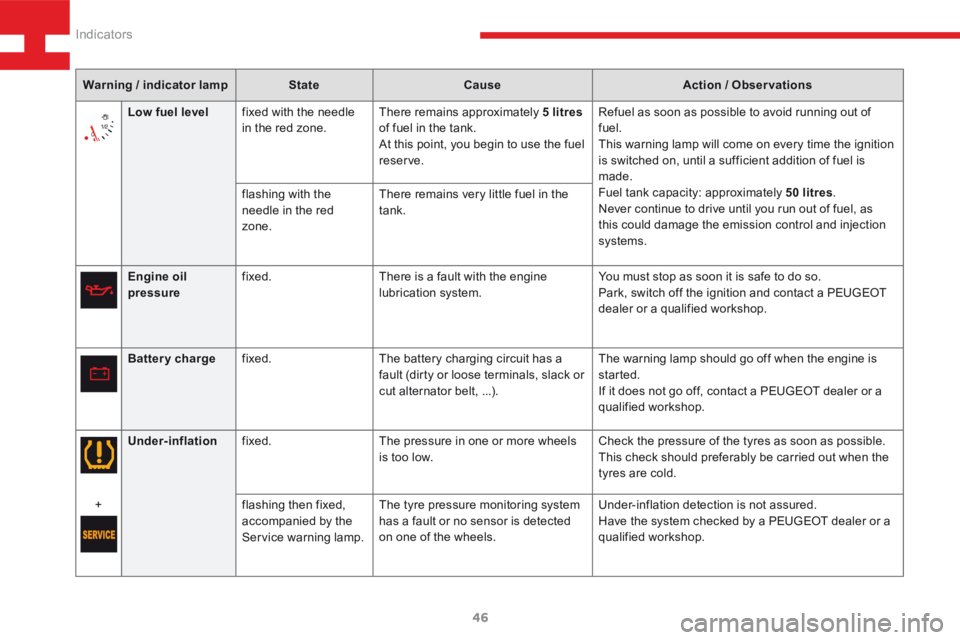
46
208_en_Chap03_Indicateurs_ed01-2015
Warning / indicator lampStateCause Action / Observations
Engine oil
pressure fixed.
There is a fault with the engine
lubrication system. You must stop as soon it is safe to do so.
Park, switch off the ignition and contact a PEUGEOT
dealer or a qualified workshop.
Battery charge fixed. The battery charging circuit has a
fault (dirty or loose terminals, slack or
cut alternator belt, ...). The warning lamp should go off when the engine is
started.
If it does not go off, contact a PEUGEOT dealer or a
qualified workshop.
Low fuel level
fixed with the needle
in the red zone. There remains approximately 5 litres
of fuel in the tank.
At this point, you begin to use the fuel
reserve. Refuel as soon as possible to avoid running out of
fuel.
This warning lamp will come on every time the ignition
is switched on, until a sufficient addition of fuel is
made.
Fuel tank capacity: approximately 50 litres
.
Never continue to drive until you run out of fuel, as
this could damage the emission control and injection
systems.
flashing with the
needle in the red
zone.
There remains very little fuel in the
tank.
Under-inflation fixed. The pressure in one or more wheels
is too low. Check the pressure of the tyres as soon as possible.
This check should preferably be carried out when the
tyres are cold.
+ flashing then fixed,
accompanied by the
Service warning lamp.The tyre pressure monitoring system
has a fault or no sensor is detected
on one of the wheels. Under-inflation detection is not assured.
Have the system checked by a PEUGEOT dealer or a
qualified workshop.
Indicators
Page 176 of 341
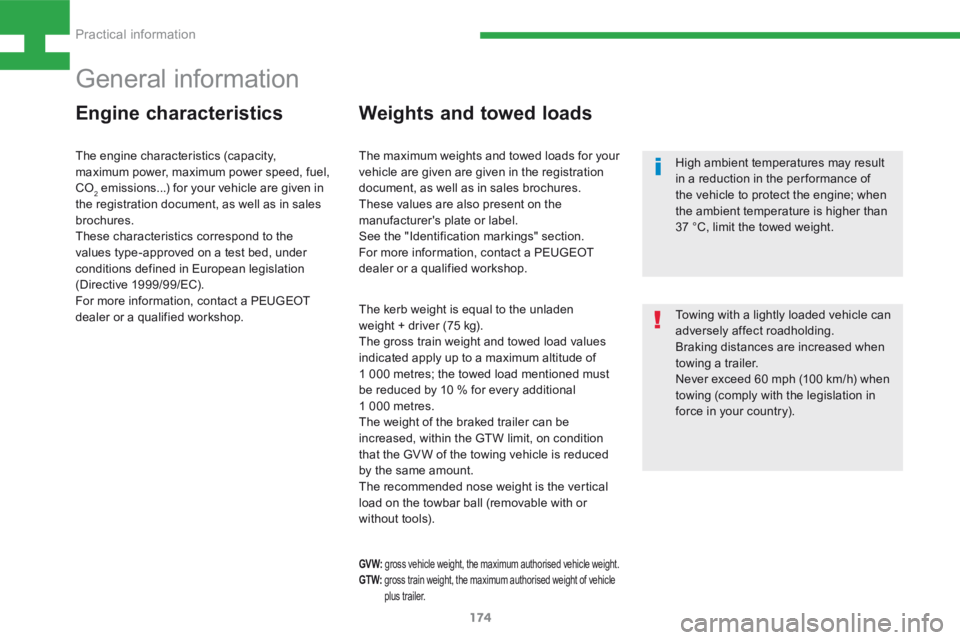
174
208_en_Chap08_Informations-pratiques_ed01-2015
General information
Engine characteristicsWeights and towed loads
The kerb weight is equal to the unladen
weight + driver (75 kg).
The gross train weight and towed load values
indicated apply up to a maximum altitude of
1 000 metres; the towed load mentioned must
be reduced by 10 % for every additional
1 000 metres.
The weight of the braked trailer can be
increased, within the GTW limit, on condition
that the GV W of the towing vehicle is reduced
by the same amount.
The recommended nose weight is the vertical
load on the towbar ball (removable with or
without tools). High ambient temperatures may result
in a reduction in the per formance of
the vehicle to protect the engine; when
the ambient temperature is higher than
37 °C, limit the towed weight.
Towing with a lightly loaded vehicle can
adversely affect roadholding.
Braking distances are increased when
towing a trailer.
Never exceed 60 mph (100 km/h) when
towing (comply with the legislation in
force in your country).
GV W:
gross vehicle weight, the maximum authorised vehicle weight.
GT W: gross train weight, the maximum authorised weight of vehicle
plus trailer.
The engine characteristics (capacity,
maximum power, maximum power speed, fuel,
CO
2 emissions...) for your vehicle are given in
the registration document, as well as in sales
brochures.
These characteristics correspond to the
values type-approved on a test bed, under
conditions defined in European legislation
(Directive 1999/99/EC).
For more information, contact a PEUGEOT
dealer or a qualified workshop. The maximum weights and towed loads for your
vehicle are given are given in the registration
document, as well as in sales brochures.
These values are also present on the
manufacturer's plate or label.
See the "Identification markings" section.
For more information, contact a PEUGEOT
dealer or a qualified workshop.
Practical information
Page 179 of 341
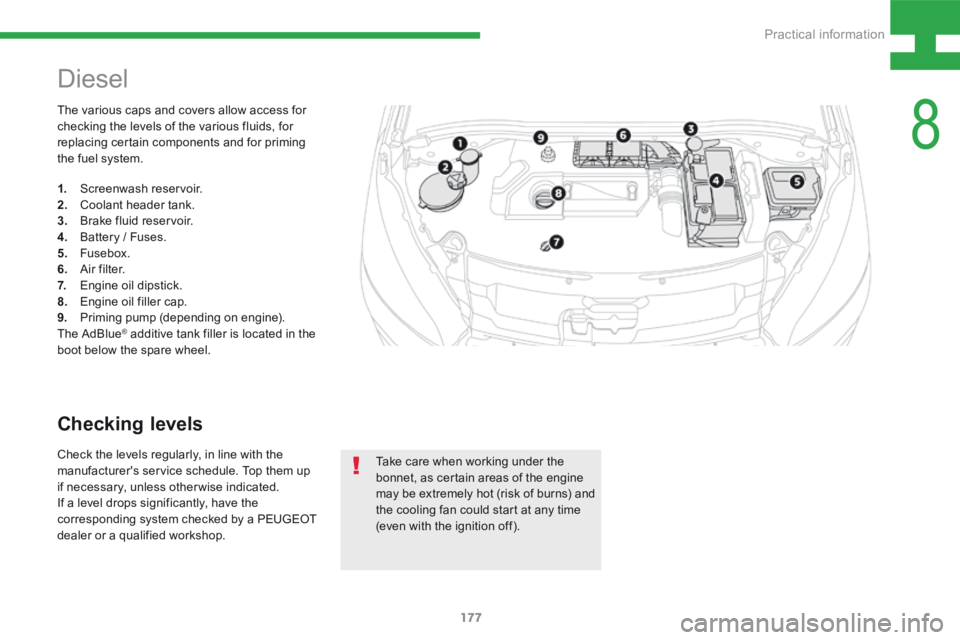
177
208_en_Chap08_Informations-pratiques_ed01-2015
The various caps and covers allow access for
checking the levels of the various fluids, for
replacing certain components and for priming
the fuel system.
Diesel
1. Screenwash reservoir.
2. Coolant header tank.
3. Brake fluid reservoir.
4. Battery / Fuses.
5. Fusebox.
6. A i r f i l t e r.
7. Engine oil dipstick.
8. Engine oil filler cap.
9. Priming pump (depending on engine).
The AdBlue
® additive tank filler is located in the
boot below the spare wheel.
Take care when working under the
bonnet, as certain areas of the engine
may be extremely hot (risk of burns) and
the cooling fan could start at any time
(even with the ignition off).
Checking levels
Check the levels regularly, in line with the
manufacturer's service schedule. Top them up
if necessary, unless otherwise indicated.
If a level drops significantly, have the
corresponding system checked by a PEUGEOT
dealer or a qualified workshop.
8
Practical information
Page 182 of 341
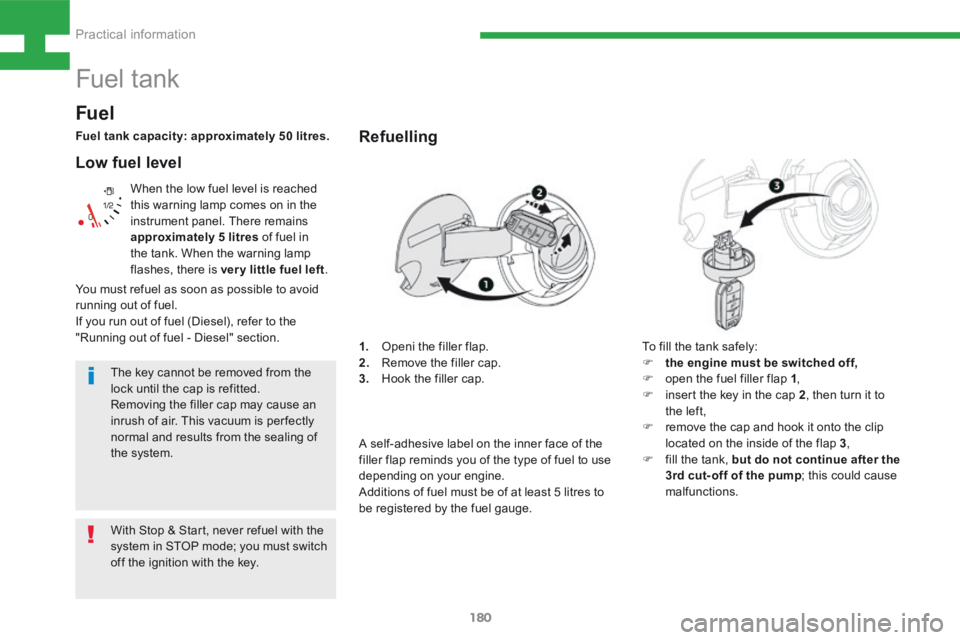
180
208_en_Chap08_Informations-pratiques_ed01-2015
Low fuel level
When the low fuel level is reached
this warning lamp comes on in the
instrument panel. There remains
approximately 5 litres of fuel in
the tank. When the warning lamp
flashes, there is ver y little fuel left .
The key cannot be removed from the
lock until the cap is refitted.
Removing the filler cap may cause an
inrush of air. This vacuum is per fectly
normal and results from the sealing of
the system.
Fuel tank
Fuel
Fuel tank capacity: approximately 50 litres.Refuelling
To fill the tank safely:
F the engine must be switched off,
F open the fuel filler flap 1 ,
F insert the key in the cap 2 , then turn it to
the left,
F remove the cap and hook it onto the clip
located on the inside of the flap 3 ,
F fill the tank, but do not continue after the
3rd cut- off of the pump ; this could cause
malfunctions.
With Stop & Start, never refuel with the
system in STOP mode; you must switch
off the ignition with the key.
You must refuel as soon as possible to avoid
running out of fuel.
If you run out of fuel (Diesel), refer to the
"Running out of fuel - Diesel" section.
A self-adhesive label on the inner face of the
filler flap reminds you of the type of fuel to use
depending on your engine.
Additions of fuel must be of at least 5 litres to
be registered by the fuel gauge.
1.
Openi the filler flap.
2. Remove the filler cap.
3. Hook the filler cap.
Practical information
Page 183 of 341
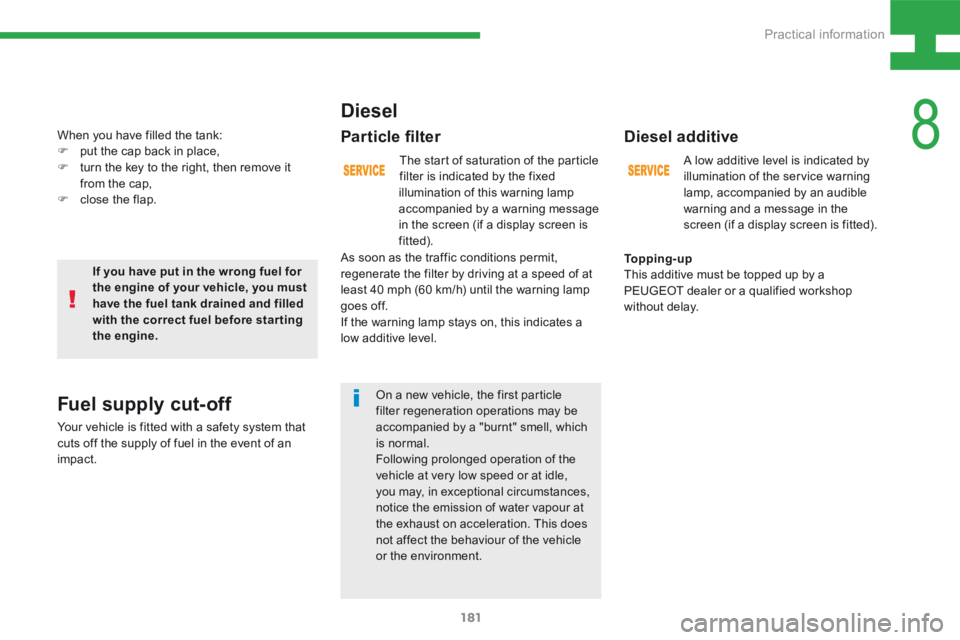
181
208_en_Chap08_Informations-pratiques_ed01-2015
If you have put in the wrong fuel for
the engine of your vehicle, you must
have the fuel tank drained and filled
with the correct fuel before star ting
the engine.
When you have filled the tank:
F
put the cap back in place,
F turn the key to the right, then remove it
from the cap,
F close the flap.
Diesel
The start of saturation of the particle
filter is indicated by the fixed
illumination of this warning lamp
accompanied by a warning message
in the screen (if a display screen is
fitted).
On a new vehicle, the first particle
filter regeneration operations may be
accompanied by a "burnt" smell, which
is normal.
Following prolonged operation of the
vehicle at very low speed or at idle,
you may, in exceptional circumstances,
notice the emission of water vapour at
the exhaust on acceleration. This does
not affect the behaviour of the vehicle
or the environment.
As soon as the traffic conditions permit,
regenerate the filter by driving at a speed of at
least 40 mph (60 km/h) until the warning lamp
goes off.
If the warning lamp stays on, this indicates a
low additive level.
To p p i n g - u p
This additive must be topped up by a
PEUGEOT dealer or a qualified workshop
without delay.
Diesel additive
A low additive level is indicated by
illumination of the service warning
lamp, accompanied by an audible
warning and a message in the
screen (if a display screen is fitted).
Fuel supply cut-off
Your vehicle is fitted with a safety system that
cuts off the supply of fuel in the event of an
impact.
Particle filter
8
Practical information
Page 184 of 341
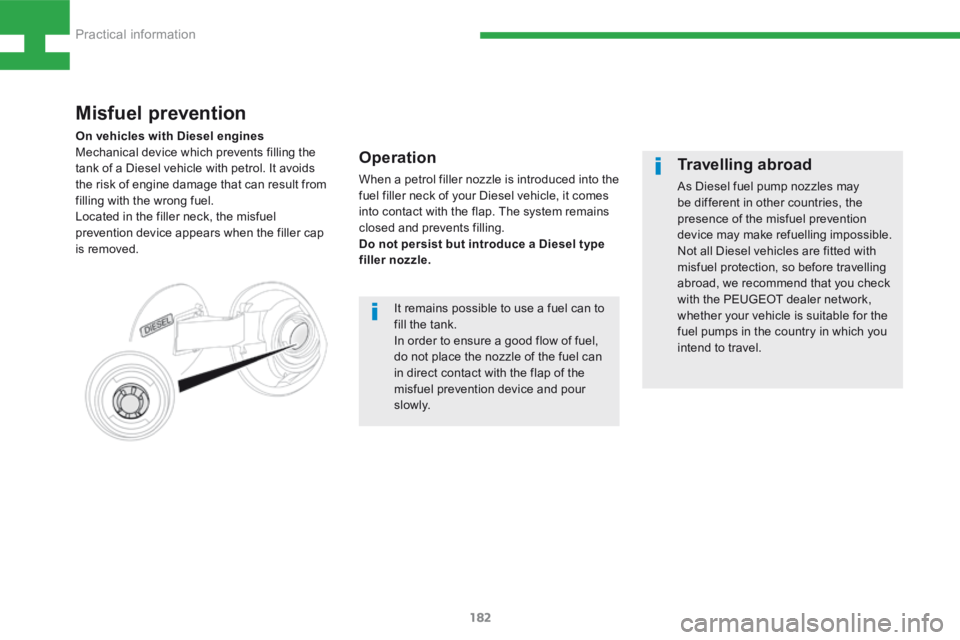
182
208_en_Chap08_Informations-pratiques_ed01-2015
Operation
When a petrol filler nozzle is introduced into the
fuel filler neck of your Diesel vehicle, it comes
into contact with the flap. The system remains
closed and prevents filling.
Do not persist but introduce a Diesel type
filler nozzle.
Misfuel prevention
On vehicles with Diesel engines
Mechanical device which prevents filling the
tank of a Diesel vehicle with petrol. It avoids
the risk of engine damage that can result from
filling with the wrong fuel.
Located in the filler neck, the misfuel
prevention device appears when the filler cap
is removed.It remains possible to use a fuel can to
fill the tank.
In order to ensure a good flow of fuel,
do not place the nozzle of the fuel can
in direct contact with the flap of the
misfuel prevention device and pour
s l ow l y.
Travelling abroad
As Diesel fuel pump nozzles may
be different in other countries, the
presence of the misfuel prevention
device may make refuelling impossible.
Not all Diesel vehicles are fitted with
misfuel protection, so before travelling
abroad, we recommend that you check
with the PEUGEOT dealer network,
whether your vehicle is suitable for the
fuel pumps in the country in which you
intend to travel.
Practical information
Page 321 of 341
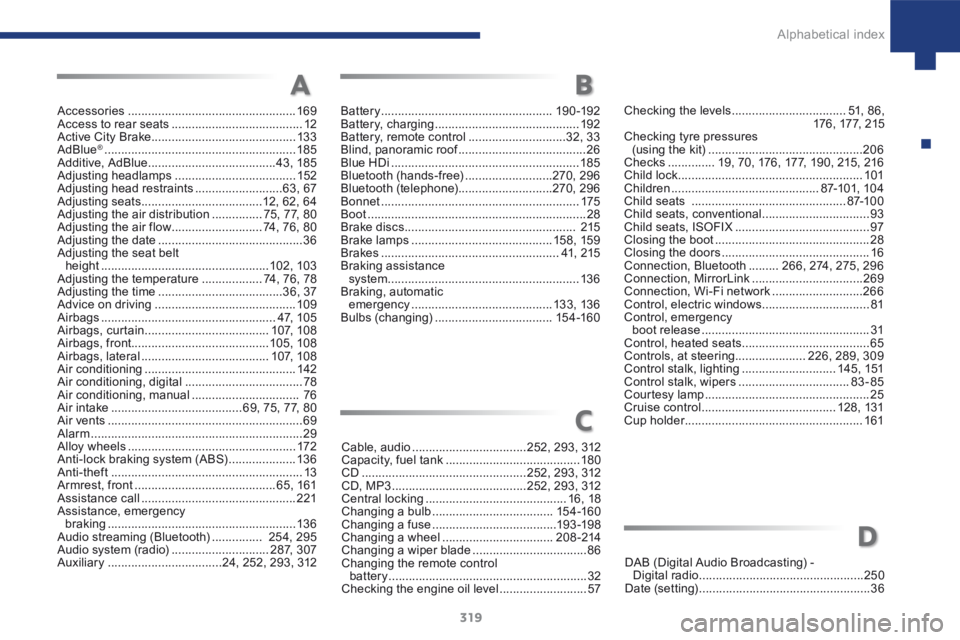
319
208_en_Chap10_index-alpha_ed01-2015
Accessories .................................................. 169
Access to rear seats ....................................... 12
Active City Brake ........................................... 13 3
AdBlue
® ......................................................... 185
Additive, AdBlue ...................................... 43, 185
Adjusting headlamps .................................... 152
Adjusting head restraints ..........................63, 67
Adjusting seats .................................... 12, 62, 64
Adjusting the air distribution ...............75, 77, 80
Adjusting the air flow ...........................74, 76, 80
Adjusting the date ........................................... 36
Adjusting the seat belt height .................................................. 102, 103
Adjusting the temperature .................. 74, 76, 78
Adjusting the time ..................................... 36, 37
Advice on driving .......................................... 109
Airbags .................................................... 4 7, 1 0 5
Airbags, curtain ..................................... 107, 108
Airbags, front ......................................... 105, 108
Airbags, lateral ...................................... 107, 108
Air conditioning ............................................. 142
Air conditioning, digital ...................................78
Air conditioning, manual ................................ 76
Air intake ....................................... 69, 75, 77, 80
Air vents .......................................................... 69
Alarm ............................................................... 29
Alloy wheels .................................................. 172
Anti-lock braking system (ABS) .................... 13 6
Anti-theft ......................................................... 13
Armrest, front .......................................... 65, 161
Assistance call .............................................. 221
Assistance, emergency braking ........................................................ 13 6
Audio streaming (Bluetooth) ............... 254, 295
Audio system (radio) ............................. 287, 307
Auxiliary .................................. 24, 252, 293, 312 Cable, audio
.................................. 252, 293, 312
Capacity, fuel tank ........................................ 180
CD ................................................. 252, 293, 312
CD, MP3 ........................................ 252, 293, 312
Central locking .......................................... 16, 18
Changing a bulb .................................... 15 4 -16 0
Changing a fuse ..................................... 193 -198
Changing a wheel ................................. 20 8 -214
Changing a wiper blade ..................................86
Changing the remote control battery ........................................................... 32
Checking the engine oil level ..........................57Checking the levels
.................................. 51, 8 6 ,
176 , 17 7, 215
Checking tyre pressures (using the kit) .............................................. 206
Checks .............. 19, 70, 176, 177, 190, 215, 216
Child lock ....................................................... 101
Children ............................................ 87-101, 104
Child seats .............................................. 87-10 0
Child seats, conventional ................................93
Child seats, ISOFIX ........................................ 97
Closing the boot .............................................. 28
Closing the doors ............................................ 16
Connection, Bluetooth .........266, 274, 275, 296
Connection, MirrorLink .................................269
Connection, Wi-Fi network ...........................266
Control, electric windows ................................81
Control, emergency boot release .................................................. 31
Control, heated seats ...................................... 65
Controls, at steering .....................226, 289, 309
Control stalk, lighting ............................ 14 5 , 151
Control stalk, wipers ................................. 83-85
Courtesy lamp ................................................. 25
Cruise control ........................................ 128, 131
Cup holder ..................................................... 161
A
C
Battery ................................................... 19 0 -192
Battery, charging ........................................... 192
Battery, remote control ............................. 32, 33
Blind, panoramic roof ...................................... 26
Blue HDi ........................................................ 185
Bluetooth (hands-free) .......................... 270, 296
Bluetooth (telephone) ............................270, 296
Bonnet ........................................................... 175
Boot ................................................................. 28
Brake discs ................................................... 215
Brake lamps .......................................... 15 8, 159
Brakes ..................................................... 41, 215
Braking assistance system ......................................................... 13 6
Braking, automatic emergency .......................................... 13 3, 13 6
Bulbs (changing) ................................... 15 4 -16 0
B
DAB (Digital Audio Broadcasting) -
Digital radio ................................................. 250
Date (setting) ................................................... 36
D
.
Alphabetical index